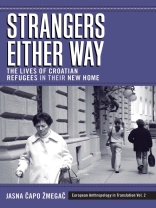Croatia gained the world’s attention during the break-up of Yugoslavia in the early 1990s. In this context its image has been overshadowed by visions of ethnic conflict and cleansing, war crimes, virulent nationalism, and occasionally even emergent regionalism. Instead of the norm, this book offers a diverse insight into Croatia in the 1990s by dealing with one of the consequences of the war: the more or less forcible migration of Croats from Serbia and their settlement in Croatia, their ‘ethnic homeland.’ This important study shows that at a time in which Croatia was perceived as a homogenized nation-in-the-making, there were tensions and ruptures within Croatian society caused by newly arrived refugees and displaced persons from Serbia and Bosnia and Herzegovina. Refugees who, in spite of their common ethnicity with the homeland population, were treated as foreigners; indeed, as unwanted aliens.
Содержание
List of Maps
Acknowledgements
Maps
Introduction
Chapter 1. The Ethnology of Individuals
The individual and her/his culture
The relational notion of identity
Case study: the Srijem Croats
Polyphony, hybridity, levels of reading: methodological-epistemological remarks
The Srijem case as an instance of coethnic migrations
Chapter 2. Srijem Croats Talk about Themselves
Exchanges
One’s own and other people’s nostalgia
Chapter 3. Identity Building in the Local Environment
‘If they are doing well, we are doing well too’: resignation
‘We will never get over it’: the Srijem sorrow
‘There’s no going back, you have to go forward’: integration
Ethnocentrism of the newcomers
Chapter 4. The Older Generation and the Migration
Before the migration: ‘There was money! What a life! Real life!’
Reasons for leaving Srijem and making the decision to move
The resettlement: the grandfathers deciding
In the new surroundings
From domination to dependence
Chapter 5. Constructing Difference, Identifying the Self
Attribution of difference and symbolism of collective identity
‘Good’ and ‘bad’ Croats or how to measure Croatian-ness
About the same thing from the other side: statements by the local population in Gradina
Chapter 6. Between Individual and Collective Integration into Croatian Society
At the outset: categorizing the settlers
Activities of the migrant association
The leaders’ dilemma: equal citizens or a ‘sect of Srijem Croats’
Chapter 7. Community, Identification, Interaction
Antagonism between ‘the established’ and ‘the outsiders’
The local population’s perspective
The stereotyped rhetoric of difference
Stereotyping and individualization
The ease of person-to-person interaction
Conclusions
Epilogue: Ethnologist and Her/His Public
To take the standpoint of the researched or not?
Reactions to the restitution of the research
Further unwanted consequences of restitution
How to protect the researched In the end: the distinct position of an ethnologist at home
Bibliography
Index
Об авторе
Jasna Čapo Zmegač is a senior research fellow at the Institute of Ethnology and Folklore Research in Zagreb and adjunct professor at the University of Zagreb. She has a multi-disciplinary background in ethnology, cultural anthropology, demography and French literature. She studied at the University of Zagreb before doing her MA and Ph D at Berkeley. She was a postdoctoral fellow in Strasbourg and Vienna, a Humboldt Fellow in Munich and Berlin, and a visiting fellow at various European universities. Her current research interests are in the field of anthropology of migration, especially forced and labor migration, and the politics of identity construction in diaspora settings. Her recent publications include the co-edited volume (with C. Voß and K. Roth) Co-ethnic Migrations Compared: Central and Eastern European Contexts (Munich: Kubon & Sagner, 2010), as well as refereed articles and chapters published in English, French, German, Croatian, and other European languages.












